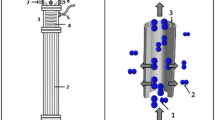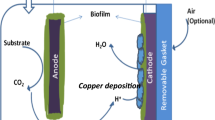Abstract
This study firstly introduced a silicone rubber membrane (SRM) into microbial fuel cell (MFC) for passive oxygen supply to simultaneously remove phenol and nitrogen from synthetic coke-oven wastewater diluted with seawater. Passive oxygen transport with biofilm on the membrane was improved by ~ 18-fold in comparison with the one without a biofilm. In addition, although the oxygen supply was passive, nitrification accounted for 34% of those aeration conditions. It was also found that silicone rubber membrane can control NO2−–N and/or NO3−–N production. A dual-chamber MFC treating the synthetic coke-oven wastewater achieved a maximum power density of 54 mW m−2 with a coulombic efficiency of 2.7%. We conclude that silicone rubber membrane is effective for sustainable coke-oven wastewater treatment in MFCs.






Similar content being viewed by others
References
Chang, E.-E., Hsing, H.-J., Chiang, P.-C., Chen, M.-Y., & Shyng, J.-Y. (2008). The chemical and biological characteristics of coke-oven wastewater by ozonation. Journal of Hazardous Materials, 156(1–3), 560–567.
Lim, B.-R., Hu, H.-Y., & Fujie, K. (2003). Biological degradation and chemical oxidation characteristics of coke-oven wastewater. Water, Air, and Soil Pollution, 146(1–4), 23–33.
Quan, X., Wang, F., Zhao, Q., Zhao, T., & Xiang, J. (2009). Air stripping of ammonia in a water-sparged aerocyclone reactor. Journal of Hazardous Materials, 170(2–3), 983–988.
Lim, B.-R., Hu, H.-Y., Huang, X., & Fujie, K. (2002). Effect of seawater on treatment performance and microbial population in a biofilter treating coke-oven wastewater. Process Biochemistry, 37(9), 943–948.
Shaw, K. (1993). Biological treatment of full-strength coke plant wastewater at Geneva steel. Iron and Steel Engineer , 70(8), 29–32.
Li, Y., Gu, G., Zhao, J., Yu, H., Qiu, Y., & Peng, Y. (2003). Treatment of coke-plant wastewater by biofilm systems for removal of organic compounds and nitrogen. Chemosphere, 52(6), 997–1005.
Larsen, T. A., & Gujer, W. (1997). The concept of sustainable urban water management. Water Science and Technology, 35(9), 3–10.
Logan, B. E. (2008). Microbial fuel cells. John Wiley & Sons, Inc., NJ
Du, Z., Li, H., & Gu, T. (2007). A state of the art review on microbial fuel cells: a promising technology for wastewater treatment and bioenergy. Biotechnology Advances, 25(5), 464–482.
Pandey, P., Shinde, V. N., Deopurkar, R. L., Kale, S. P., Patil, S. A., & Pant, D. (2016). Recent advances in the use of different substrates in microbial fuel cells toward wastewater treatment and simultaneous energy recovery. Applied Energy, 168, 706–723.
Luo, H., Liu, G., Zhang, R., & Jin, S. (2009). Phenol degradation in microbial fuel cells. Chemical Engineering Journal, 147(2–3), 259–264.
Friman, H., Schechter, A., Nitzan, Y., & Cahan, R. (2013). Phenol degradation in bio-electrochemical cells. International Biodeterioration & Biodegradation, 84, 155–160.
Buitrón, G., & Moreno-Andrade, I. (2014). Performance of a single-chamber microbial fuel cell degrading phenol: effect of phenol concentration and external resistance. Applied Biochemistry and Biotechnology, 174(7), 2471–2481.
Virdis, B., Rabaey, K., Yuan, Z., & Keller, J. (2008). Microbial fuel cells for simultaneous carbon and nitrogen removal. Water Research, 42(12), 3013–3024.
Virdis, B., Rabaey, K., Rozendal, R. A., Yuan, Z., & Keller, J. (2010). Simultaneous nitrification, denitrification and carbon removal in microbial fuel cells. Water Research, 44(9), 2970–2980.
Zhang, X., Zhu, F., Chen, L., Zhao, Q., & Tao, G. (2013). Removal of ammonia nitrogen from wastewater using an aerobic cathode microbial fuel cell. Bioresource Technology, 146, 161–168.
Sotres, A., Cerrillo, M., Viñas, M., & Bonmatí, A. (2016). Nitrogen removal in a two-chambered microbial fuel cell: establishment of a nitrifying–denitrifying microbial community on an intermittent aerated cathode. Chemical Engineering Journal, 284, 905–916.
Zhang, G., Zhang, H., Ma, Y., Yuan, G., Yang, F., & Zhang, R. (2014). Membrane filtration biocathode microbial fuel cell for nitrogen removal and electricity generation. Enzyme and Microbial Technology, 60, 56–63.
Yan, H., Saito, T., & Regan, J. M. (2012). Nitrogen removal in a single-chamber microbial fuel cell with nitrifying biofilm enriched at the air cathode. Water Research, 46(7), 2215–2224.
Bronzino, J. D. (1999). The biomedical engineering handbook, Two Volume Set, 2nd ed., CRC Press:Boca Raton, FL.
Gong, Z., Yang, F., Liu, S., Bao, H., Hu, S., & Furukawa, K. (2007). Feasibility of a membrane-aerated biofilm reactor to achieve single-stage autotrophic nitrogen removal based on Anammox. Chemosphere, 69(5), 776–784.
Terada, A., Yamamoto, T., Igarashi, R., Tsuneda, S., & Hirata, A. (2006). Feasibility of a membrane-aerated biofilm reactor to achieve controllable nitrification. Biochemical Engineering Journal, 28(2), 123–130.
Hu, S., Yang, F., Liu, S., & Yu, L. (2009). The development of a novel hybrid aerating membrane-anaerobic baffled reactor for the simultaneous nitrogen and organic carbon removal from wastewater. Water Research, 43(2), 381–388.
Yu, C.-P., Liang, Z., Das, A., & Hu, Z. (2011). Nitrogen removal from wastewater using membrane aerated microbial fuel cell techniques. Water Research, 45(3), 1157–1164.
Semmens, M. J., Dahm, K., Shanahan, J., & Christianson, A. (2003). COD and nitrogen removal by biofilms growing on gas permeable membranes. Water Research, 37(18), 4343–4350.
Yang, Y., Li, X., Yang, X., & He, Z. (2017). Enhanced nitrogen removal by membrane-aerated nitritation-anammox in a bioelectrochemical system. Bioresource Technology, 238, 22–29.
Smolders, G., Van der Meij, J., Van Loosdrecht, M., & Heijnen, J. (1994). Model of the anaerobic metabolism of the biological phosphorus removal process: stoichiometry and pH influence. Biotechnology and Bioengineering, 43(6), 461–470.
Sueoka, K., Satoh, H., Onuki, M., & Mino, T. (2009). Microorganisms involved in anaerobic phenol degradation in the treatment of synthetic coke-oven wastewater detected by RNA stable-isotope probing. FEMS Microbiology Letters, 291(2), 169–174.
APHA. (1998). Standard methods for the examination of water and wastewater (20th ed.). Washington DC: American Public Health Association.
Watanabe, K. (2008). Recent developments in microbial fuel cell technologies for sustainable bioenergy. Journal of Bioscience and Bioengineering, 106(6), 528–536.
Logan, B. E., Hamelers, B., Rozendal, R., Schröder, U., Keller, J., Freguia, S., Aelterman, P., Verstraete, W., & Rabaey, K. (2006). Microbial fuel cells: methodology and technology. Environmental Science & Technology, 40(17), 5181–5192.
Puig, S., Coma, M., Desloover, J., Boon, N., Colprim, J. S., & Balaguer, M. D. (2012). Autotrophic denitrification in microbial fuel cells treating low ionic strength waters. Environmental Science & Technology, 46(4), 2309–2315.
Feng, C., Huang, L., Yu, H., Yi, X., & Wei, C. (2015). Simultaneous phenol removal, nitrification and denitrification using microbial fuel cell technology. Water Research, 76, 160–170.
Henze, M., Gujer, W., Mino, T., & Van Loosdrecht, M. C. M. (2000). Activated sludge models ASM1, ASM2, ASM2d and ASM3. Scientific and Technical Report No. 9. IWA publishing, London.
Kuntke, P., Śmiech, K., Bruning, H., Zeeman, G., Saakes, M., Sleutels, T., Hamelers, H., & Buisman, C. (2012). Ammonium recovery and energy production from urine by a microbial fuel cell. Water Research, 46(8), 2627–2636.
Suzuki, Y., Miyahara, S., & Takeishi, K. (1990). Research on wastewater treatment method using gas permeable film. Proceedings of Environmental and Sanitary Engineering Research, 27, 65–74 (in Japanese).
Okabe, S., Naitoh, H., & Watanabe, Y. (1999). Spatial distributions of ammonia-oxidizing bacteria in wastewater biofilms analyzed by fluorescent in situ hybridization. Journal of Japan Society on Water Environment, 22(3), 191–198 (in Japanese).
Lefebvre, O., & Moletta, R. (2006). Treatment of organic pollution in industrial saline wastewater: a literature review. Water Research, 40(20), 3671–3682.
Kugelman, I. J., & McCarty, P. L. (1965). Cation toxicity and stimulation in anaerobic waste treatment. J.Water Pollut. Control Fed., 37, 97–116.
Lefebvre, O., Tan, Z., Kharkwal, S., & Ng, H. Y. (2012). Effect of increasing anodic NaCl concentration on microbial fuel cell performance. Bioresource Technology, 112, 336–340.
Liu, H., & Logan, B. E. (2004). Electricity generation using an air-cathode single chamber microbial fuel cell in the presence and absence of a proton exchange membrane. Environmental Science & Technology, 38(14), 4040–4046.
Liu, H., Cheng, S., & Logan, B. E. (2005). Production of electricity from acetate or butyrate using a single-chamber microbial fuel cell. Environmental Science & Technology, 39(2), 658–662.
Song, T.-s., Wu, X.-y., & Zhou, C. C. (2014). Effect of different acclimation methods on the performance of microbial fuel cells using phenol as substrate. Bioprocess and Biosystems Engineering, 37(2), 133–138.
Ter Heijne, A., Hamelers, H. V., De Wilde, V., Rozendal, R. A., & Buisman, C. J. (2006). A bipolar membrane combined with ferric iron reduction as an efficient cathode system in microbial fuel cells. Environmental Science & Technology, 40(17), 5200–5205.
Li, X. M., Cheng, K. Y., & Wong, J. W. (2013). Bioelectricity production from food waste leachate using microbial fuel cells: effect of NaCl and pH. Bioresource Technology, 149, 452–458.
Liu, H., Cheng, S., & Logan, B. E. (2005). Power generation in fed-batch microbial fuel cells as a function of ionic strength, temperature, and reactor configuration. Environmental Science & Technology, 39(14), 5488–5493.
Henze, M., van Loosdrecht, M. C., Ekama, G. A., & Brdjanovic, D. (2008). Biological wastewatertreatment: principles, modelling and design. IWA publishing, London.
Acknowledgments
This research was supported by the Steel Foundation for Environmental Protection Technology.
Author information
Authors and Affiliations
Corresponding author
Additional information
Publisher’s Note
Springer Nature remains neutral with regard to jurisdictional claims in published maps and institutional affiliations.
Electronic supplementary material
ESM 1
(DOCX 735 kb)
Rights and permissions
About this article
Cite this article
Wang, F., Matsubara, H., Nittami, T. et al. Utilization of a Silicone Rubber Membrane for Passive Oxygen Supply in a Microbial Fuel Cell Treating Carbon and Nitrogen from Synthetic Coke-Oven Wastewater. Appl Biochem Biotechnol 189, 217–232 (2019). https://doi.org/10.1007/s12010-019-02994-3
Received:
Accepted:
Published:
Issue Date:
DOI: https://doi.org/10.1007/s12010-019-02994-3




